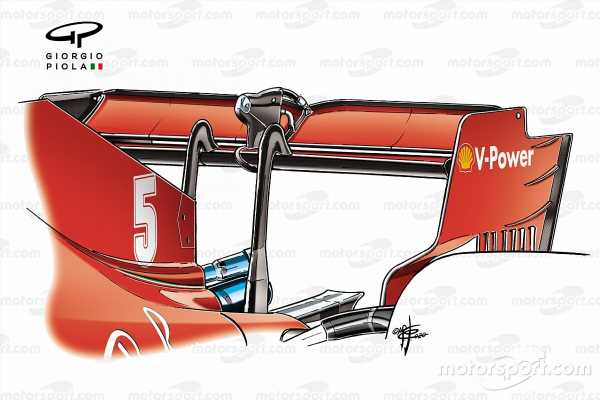In the ongoing development war between Formula 1’s teams, keep up to date with what’s new in our regular technical updates. Today, let’s look at four outfits at the British Grand Prix – Mercedes, Ferrari, Racing Point and Red Bull.
Teams arrived at the British GP knowing that the track posed a very different challenge compared with the opening three rounds. With the top four teams showing varying degrees of strengths and weaknesses, we saw an array of downforce levels chosen at Silverstone.
Mercedes
Mercedes F1 W11 rear wing detail British GP
Photo by: Giorgio Piola
Mercedes AMG F1 W11 rear wing
Photo by: Giorgio Piola
The superior level of downforce that the W11 possesses compared with its predecessor had already seen Mercedes taking less wing angle, relative to last year, in the opening few races. And it’s a trend that’s continued for Silverstone (above left) – it ran less wing angle than earlier this season (above right), while also stripping the Gurney tab from the trailing edge of the upper flap.
It’s also worth noting that this lower downforce design also features the single-mounting pillar tested at the last pre-season test and featured in the revised wing that the team used at the Styrian GP.
The use of a single pillar design has both positives and negatives, with the major positive in this instance being aerodynamic, as a single pillar should cause less flow separation across the wing span, which is critical when you’ve reduced the size of the mainplane in the way that Mercedes have.
Furthermore, as the pillar mounts to the underside of the wing, rather than using swan-neck supports, there’s less disturbance on the upper side of the wing, leaving just the DRS pod to contend with, the shape of which is also different, owing to the pillar’s connection to it.
Ferrari
Ferrari SF1000 rear wing detail British GP
Photo by: Giorgio Piola
Ferrari continues to struggle with a top-speed deficit to its rivals, due to the changes that have been forced upon the power unit, resulting in a deficit of around 40bhp to Mercedes, who found extra performance for 2020.
The Scuderia opted for the lowest downforce rear wing on show at Silverstone, as it looked to reduce drag levels as much as possible. That decision comes with its own pain, however, as reducing the level of downforce means the car is compromised in the corners, which then has a negative effect on tyre life and performance.
To help compare and contrast the relative fortunes of Ferrari this year with those of last, here’s a shot of the rear wing deployed in 2019 (left), which not only featured dramatically more surface area, albeit with the spoon shaping, it also featured a T-Wing.
This goes to show the levels that the team is prepared to go to try and offset the current power unit deficit.
Racing Point
Racing Point RP20 rear wing detail British GP
Photo by: Giorgio Piola
At the other end of the spectrum to Ferrari was Racing Point, who not only decided to run with a much more substantially sized rear wing – akin to what we’ve seen in the opening rounds – it also continued to utilize a T-Wing too.
This extra downforce undoubtedly made the car much more stable through the high-speed corners than its rivals, which came at the cost of a higher drag penalty that undoubtedly had an impact on straightline speed.
Fortunately, the gains made by Mercedes HPP this year allowed Racing Point to offset that drag penalty to some degree at Silverstone. But it will have to revisit that decision going forward, especially with Spa and Monza on the horizon.
Red Bull
Red Bull Racing RB16 rear wing detail British GP
Photo by: Giorgio Piola
Red Bull Racing RB16 rear wing endplate comparison
Photo by: Giorgio Piola
Red Bull was another team to try a new rear wing for the British GP, as it too hoped to shed some drag and improve straightline speed. This is the third rear wing configuration we’ve seen the team use in four races, with yet more new features and the return of some old ones too.
The wing featured the curved spoon-shaped mainplane that we’re accustomed to seeing teams use to retain downforce and stability but also cut back on some of the drag.
Source: Read Full Article








